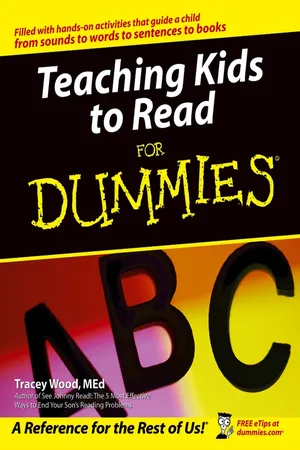
Teaching Kids to Read For Dummies
Tracey Wood
- English
- ePUB (apto para móviles)
- Disponible en iOS y Android
Teaching Kids to Read For Dummies
Tracey Wood
Información del libro
You're thinking of teaching a child to read. What a great idea! Now all you need is exactly the right blueprint. This easy-to-follow book is written with two people in mind; you, and the child you're thinking of teaching. Mother and children's reading specialist Tracey Wood gives you all the down-to-earth, honest information you need to give a child a happy, solid start with reading.
Teaching Kids to Read For Dummies is for parents of young children who want to give their kids a head start by teaching them to read before they enter school or to supplement their children's school instruction, as well as teachers and caregivers of young children. Filled with hands-on activities that progress a child from sounds to words to sentences to books, this friendly guide shows you how to:
- Prepare a child to read
- Sharpen his listening skills
- Correct her errors graciously
- Choose the right books
- Have kids read out loud
- Find help if you need it
Whether the child you want to teach is two or twelve; fast paced or steady; an absolute beginner or someone who's begun but could use a little help, this empathetic book shows you how to adapt the simple, fun activities to your child's individual needs. You'll see how to make activities age appropriate, how to add more challenge or support, and how to make gender allowances if that's relevant.
Plus, you'll discover how to:
- Lay the foundation for good reading skills
- Tell the difference between a reading delay and a reading problem
- Help your child build words from letters and sounds, advance to short and long vowel words, and conquer syllables and silent letters
- Select entertaining workbooks, recycle them, and make up your own reading activities
- Get your child ready for sentences
- Keep your child reading — with others or on his own
Complete with lists of word families, phonics rules, and reading resources, Teaching Kids to Read For Dummies will help you make learning fun for your child as he or she develops this critical skill!
Preguntas frecuentes
Información
Part I
Preparing Your Child for the Road Ahead

Chapter 1
The Wonder and Power of Reading
In This Chapter




Understanding the Process




A lightning tour of sounding out

A peep at sight words

Índice
- Title
- Contents
- Introduction
- Part I : Preparing Your Child for the Road Ahead
- Chapter 1: The Wonder and Power of Reading
- Chapter 2: The Pre-Reader: Leading Up to Letters
- Chapter 3: Tigers and Teachers: Listening to Letters
- Chapter 4: m or n? b or d? Looking at Letters
- Chapter 5: Blending Letters Together
- Chapter 6: Four Special Sounds in Reading: ch, sh, ph, and th
- Part II : Building Words from Letters and Sounds
- Chapter 7: Getting Ready for Words and Sentences
- Chapter 8: Reading Short a Words
- Chapter 9: Reading Short e, i, and o Words
- Chapter 10: Reading Short u Words
- Part III : Advancing to Sight Words and Long Vowel Sounds
- Chapter 11: Understanding Sight Words
- Chapter 12: Making Big Progress with Little Rules
- Chapter 13: y: A Letter Like No Other
- Part IV : Scary Stuff Beginning with S: Soft Sounds, Suffixes, Syllables, and Silent Letters
- Chapter 14: Soft Sounds
- Chapter 15: Endings (a.k.a. Suffixes)
- Chapter 16: Chunks of Sound, or Syllables
- Chapter 17: Time to Growl: ar, or, er, ir, and ur
- Chapter 18: Silent (But Not Deadly) Letters
- Chapter 19: Getting Beyond Sounds and Rules
- Part V : Reading, Reading, and More Reading
- Chapter 20: Choosing Just-Right Reading Books
- Chapter 21: Writing and Workbooks
- Chapter 22: Having Your Child Read Out Loud
- Chapter 23: Keeping Your Child on the Reading Track
- Chapter 24: When to Get Help for Your Child
- Part VI : The Part of Tens
- Chapter 25: More Than Ten Word Families
- Chapter 26: Ten Phonics Rules
- Chapter 27: Ten Things to Help Your Budding Reader
- Chapter 28: Ten Reading Teachers’ Resources
- Appendix: A Word Family Tree